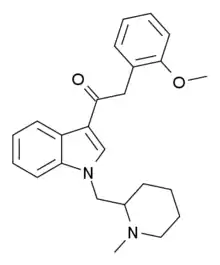Cannabipiperidiethanone
Cannabipiperidiethanone (CPE or 1-(N-methylpiperidin-2-ylmethyl)-3-(2-methoxyphenylacetyl)indole) is a synthetic cannabinoid that has been found as an ingredient of "herbal" synthetic cannabis blends sold in Japan, alongside JWH-122 and JWH-081.
 | |
| Legal status | |
|---|---|
| Legal status |
|
| Identifiers | |
IUPAC name
| |
| CAS Number | |
| ChemSpider | |
| UNII | |
| CompTox Dashboard (EPA) | |
| Chemical and physical data | |
| Formula | C24H28N2O2 |
| Molar mass | 376.500 g·mol−1 |
| 3D model (JSmol) | |
SMILES
| |
InChI
| |
Its binding affinity was measured at the CB1 and CB2 receptors and it was found to have an IC50 of 591 nM at CB1 and 968 nM at CB2, making it 2.3 times and 9.4 times weaker than JWH-250 at these two targets respectively.[1]
In the United States, CB1 receptor agonists of the 3-phenylacetylindole class such as cannabipiperidiethanone are Schedule I Controlled Substances.[2]
References
- Uchiyama N, Kikura-Hanajiri R, Goda Y (2011). "Identification of a novel cannabimimetic phenylacetylindole, cannabipiperidiethanone, as a designer drug in a herbal product and its affinity for cannabinoid CB₁ and CB₂ receptors". Chemical & Pharmaceutical Bulletin. 59 (9): 1203–5. doi:10.1248/cpb.59.1203. PMID 21881274.
- : Schedules of controlled substances
External links
This article is issued from Wikipedia. The text is licensed under Creative Commons - Attribution - Sharealike. Additional terms may apply for the media files.